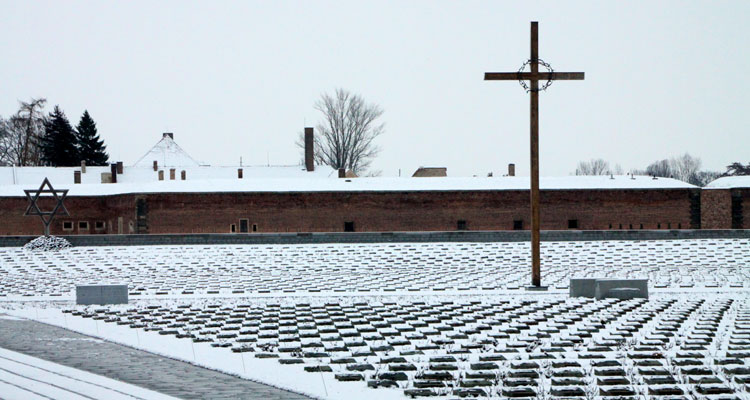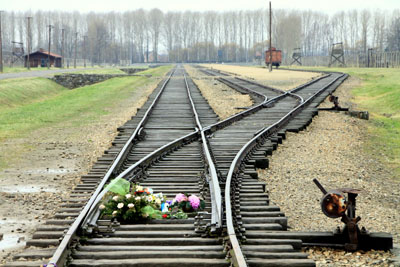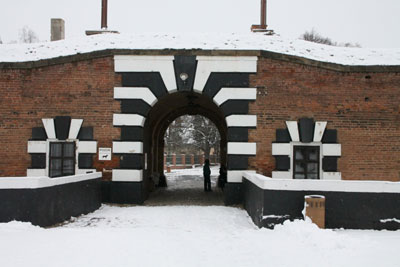Remembering a painful past
by Paula Prindle, Orient, OH
It was raining at Auschwitz — not a hard rain, just a dreary drizzle — fitting, I thought, for a concentration camp.
The term “concentration camp” has always puzzled me. Why such a bland, neutral phrase to describe a place that was anything but? These were work camps, prison camps and, yes, death camps, so why were they known as concentration camps? Perhaps because when human beings are concentrated in one place, they are easier to control; they lose their identities and, to their captors, cease to exist as individuals.
The original camp at Auschwitz (Oświeęcim), Poland, could hold 15,000 prisoners, but Auschwitz II-Birkenau, built in 1942 approximately two miles away, could hold 100,000. It was intended from the beginning to be an extermination camp.
While it is not fun to visit such places, it is important. They are a part of history — a grim part, to be sure, but a part that should not be denied or forgotten.
A sober introduction
We started our tour at the larger camp, Auschwitz II-Birkenau. The first thing we saw from the motorcoach as we pulled in was the infamous “Gate of Death.” This entrance is where trains full of deportees entered the camp. Just beyond the gate, the “selection” was carried out. It was generally a physician who indicated, by the direction of his thumb, who lived and who died.
It is estimated that of the six million Jews who did not survive the Holocaust, 1.1 million of them died at Auschwitz. One of them was the father of a member of our tour group, though we did not discover this until later.
Our guide, Jaroslaw, with his shaved head, sunken cheeks, gaunt body and somber manner, resembled photos we had seen of survivors. He did not dramatize the events here but spoke in simple words and brief sentences. This was not a memorized speech for him; he told the story as if he were delivering it for the first time.
He took us first to several wooden barracks in the men’s camp. The drafty buildings, heated only by a chimney at each end, were quite chilly on this November ’10 day. The rows and rows of bunks and the line of “latrines” testified to the hundreds who were packed into each barrack. We could only imagine the bleak nights spent here.
We shuffled back to our tour bus for the short ride to Auschwitz I. I say shuffled because the atmosphere of the camp seemed to draw our heads down and weight our steps.
We had to pass under Auschwitz I’s notorious “Arbeit Macht Frei” (“Work Makes You Free”) sign to enter the main camp. Auschwitz is not the only camp with this message; we had seen it on a previous visit to Dachau and would see it again at Theresienstadt. Nevertheless, it was a chilling greeting.
What I remember most about this camp and its museum are the piles — room-sized piles of suitcases, kitchen implements, brushes of all kinds, shoe polish and a heartbreaking mound of children’s shoes. Those sent to Auschwitz had everything taken from them.
The first gas chamber and crematorium encountered here are not far from the camp entrance. Just outside is the gallows where Rudolf Höss (often written Hoess), the first commandant of Auschwitz, was hanged on April 16, 1947, after he was tried and sentenced to death for his war crimes.
Our silent group walked through the double row of electrified barbed-wire fencing, reassembling at the bus for our return to Kraków — a return to comfortable, mundane activities.
This visit was part of Grand Circle Travel’s “The Best of Eastern Europe.” They also offer an optional excursion to Terezín, Czech Republic, on some of their tours but not on this one, so my husband, David, and I visited that camp on our own.
Theresienstadt
We broke away from our tour group in Prague a week later to head for the town of Terezín, an hour’s bus ride north. Our visit here was different from the one at Auschwitz for two reasons. For one thing, we were on our own, with no guide (except for our tour of the Small Fortress), and we had an entire day to look, absorb and feel. The second reason was that Terezín (Theresienstadt in German) was a totally different type of camp.
It had been a fortress in the Middle Ages, so it was already walled. In 1942 the population of the Main Fortress was forced to move out in order to turn the whole town into Theresienstadt, a totally Jewish ghetto/camp. It was meant to be a transit camp, where prisoners were gathered and held while “space was made for them” in other camps.
Theresienstadt had two other purposes. One was decimation — to get rid of as many Jews as possible through work and bad living conditions. The other was propaganda, and this is what set Theresienstadt apart.
The Allies were beginning to suspect what the Nazis were doing, especially to the Jews, so this “paradise ghetto” was gussied up as camouflage to squelch the rumors and show the world that, although Jews were being segregated, they were not being mistreated.
During a carefully choreographed tour of Theresienstadt for a June 1944 International Red Cross inspection visit, only certain people (newly arrived and relatively healthy) and certain areas of the ghetto were allowed to be seen. The “beautification” project made it look like the Jews living in Theresienstadt were healthy, happy and well cared for. The transports to the east recommenced shortly after the Red Cross visit.
In this town of only 7,000 pre-ghetto inhabitants, a daily average of over 55,000 Jews were billeted. 33,000 died here and another 87,000 were sent to the east in transports. Fewer than 4,000 of those survived.
The most somber statistic is that of the 15,000 children, fewer than 100 survived the war. They left behind drawings that are on display today.
But there was beauty in Theresienstadt, and there was hope. There was certainly courage. Although this “model” ghetto was intended for the Jews of Bohemia and Moravia (Czech districts), it grew to be a holding camp for “prominents” from many occupied European countries.
Rabbis, scholars, artists, composers, musicians, writers and filmmakers were sent here. Education and culture were held in high esteem. Concerted efforts were made to educate the young in the Jewish religion, customs and language and to boost the morale of fellow prisoners with plays, concerts and any other entertainment that provided hope for the future and a belief in survival.
Exploring independently
We stopped first at the Ghetto Museum. No one there spoke more than very basic memorized English sentences. This made it difficult to ask questions, but we finally managed to learn that, in addition to the many displays, there are two excellent films in English: a 30-minute history of the ghetto and a 10-minute propaganda film shot here.
When we left the museum, we walked the streets alone. There were few people to be seen. David remarked on the current inhabitants — only 3,000 now — and how “creepy” it would be to live in this memorial town.
We entered the Magdeburg Barracks to view a replica of a crowded dormitory. This building also houses exhibits detailing the cultural life of the ghetto. Then we headed back out into the deserted, snowy streets, following the “Krematorium” signs.
We finally arrived at the cemetery and crematorium. It was cold and quiet. Inside the crematorium, incongruously painted a cheery yellow, a caretaker who spoke no English attempted to give us a private tour. I noticed that I understood every third word or so; he was trying his best to speak French! However, we didn’t need a guided tour; the four ovens spoke for themselves.
The crematorium was for the disposal of the many who died in the ghetto from disease, lack of food and poor living conditions. The dead were buried in the cemetery in individual graves, initially, then in mass graves. Finally, a crematorium was necessary to handle those who died naturally in the ghetto and those who died of torture in the Small Fortress.
The Small Fortress
The Small Fortress, just outside the main fortress (the town), had been a prison for many years. Its most famous prisoner was probably Gavrilo Princip, the 19-year-old Bosnian Serb who shot and killed Archduke Franz Ferdinand and his wife — the man who started World War I. In June 1940 this prison became the Prague Gestapo Police Prison. The Theresienstadt camp was, indeed, a “paradise ghetto” compared to the Small Fortress.
We joined three young Americans for a guided tour led by Rosa, a petite Asian Czech with a great deal of enthusiasm. She took us under the “Arbeit Macht Frei” sign to the First Yard, which once housed 1,500 inmates. She pointed out the individual and group cells (including Princip’s solitary cell) and described the hardships of the prisoners, including interrogations and torture.
Rosa then led us through a very long and very claustrophobic corridor to the execution ground. It was a relief to leave the tunnel, even for such a sight. The largest execution here took place at the very end of the war, on May 2, 1945, when 52 prisoners were shot.
Outside the Small Fortress, next to the entrance, is the impressive National Cemetery. About 10,000 Nazi victims are buried here, 2,386 of them in individual graves. It was a quiet, majestic site — a fitting place to end a solemn visit to the past.
This is not a day trip for shoppers or souvenir hunters, nor for small children; it is a journey for reflection. Theresienstadt’s ghetto and its Small Fortress are emotionally exhausting; a visit is not to be taken lightly or quickly. We were there for 5½ hours. We would have liked to stay another hour or so, but we were at the mercy of the public bus schedule and our group’s farewell dinner in Prague that evening.
If you go, do it right and plan to spend an entire day. The three young people who toured the Small Fortress with us were on a too-tight schedule and had to bypass the main part of town.
We took a public bus to Theresienstadt from Prague’s Holešovice train station (on metro line C). You can find timetables online; click on the link at the bottom of the page and select ”direct connections only” for proper schedule). The ride departs from Platform 7 and takes 50 to 65 minutes, depending on the route. Buy your tickets from the bus driver. We paid CZK80 ($4.30) per person, each way.
There are two bus stops in Terezín: one on the main square, just around the corner from the Ghetto Museum, and one near the Small Fortress. We recommend beginning in town at the Ghetto Museum and ending at the Small Fortress.
A ticket for all of Terezin’s sights cost CZK200 ($11.70). Advance reservations can be made online; visit www.pamatnik-terezin.cz.
We found both Auschwitz and Theresienstadt to be moving and educational. They testify that people could and did treat each other abominably because they were different — not because they were evil or dangerous or better or worse than the rest of us but because they were different.



